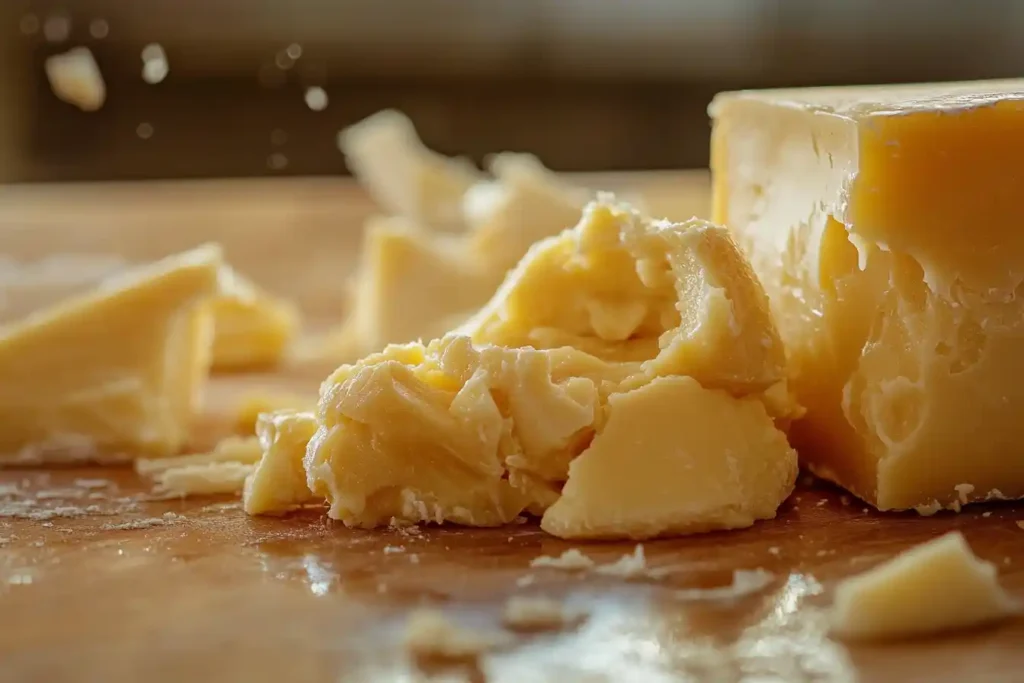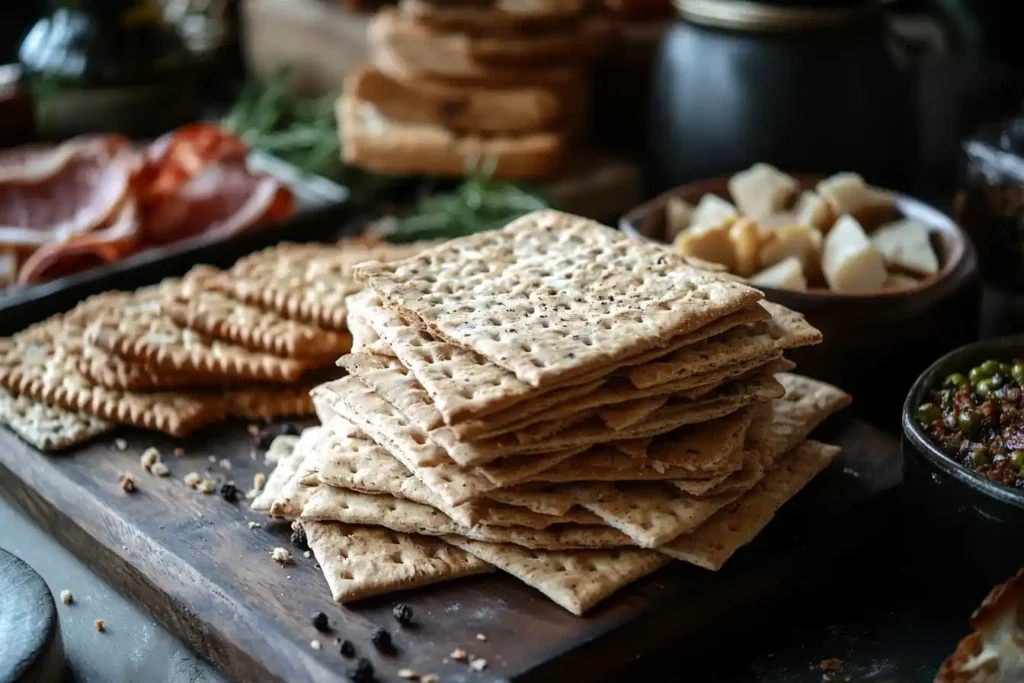Introduction
A charcuterie board is more than just a food platter—it’s a visual and flavorful experience meant to impress guests and satisfy appetites. With its combination of cured meats, cheeses, fruits, nuts, and spreads, it offers a balanced variety of tastes and textures.
However, not everything belongs on a charcuterie board. Adding the wrong ingredients can disrupt the harmony, compromise freshness, or even create a messy presentation. Knowing what not to include is just as important as selecting the right components.
In this guide, we’ll explore which foods and items to avoid to keep your charcuterie board visually appealing, practical, and delicious.
Foods That Don’t Belong on a Charcuterie Board
Strong-Smelling or Overpowering Ingredients
A charcuterie board should balance flavors without overwhelming the senses. Strong-smelling ingredients can dominate the board and make it unpleasant for some guests.
- Avoid: Blue cheeses with extreme aromas, fermented vegetables like kimchi, or heavily spiced meats.
- Why? These overpower the delicate flavors of other ingredients and can deter guests with sensitive palates.
Wet and Soggy Items That Compromise Texture
Moisture can ruin the crispness of crackers and the texture of meats and cheeses.
- Avoid: Wet fruits like watermelon, juicy tomatoes, or overly marinated vegetables.
- Why? These items can leak and create a soggy mess, making the board look unappealing and difficult to manage.
Messy or Hard-to-Handle Foods
Finger foods should be easy to pick up and eat. Messy items requiring utensils or napkins can disrupt the relaxed vibe of a charcuterie board.
- Avoid: Sticky sauces, barbecue meats, or crumbly pastries.
- Why? They’re challenging to serve and eat without making a mess.
Highly Perishable Ingredients Without Preservation
Since charcuterie boards often sit out for hours, temperature-sensitive ingredients can spoil quickly.
- Avoid: Seafood, sushi, and dairy-based dips that require refrigeration.
- Why? They pose food safety risks and might lose their appeal as they sit out.
Common Mistakes with Meat Selections
Processed Deli Meats vs. Artisan Cured Meats
Not all meats are suitable for a charcuterie board. Processed deli meats like bologna or turkey slices lack the rich flavor and texture of high-quality cured meats.
- Avoid: Packaged lunch meats or pre-sliced meats with artificial preservatives.
- Why? They appear less elegant and don’t provide the same flavor complexity as artisanal cured meats like prosciutto, salami, and chorizo.
Overcrowding with Too Many Flavors
Too many different meat varieties can overwhelm guests and clash with other items.
- Avoid: Adding more than 3–4 types of meats.
- Why? It’s better to focus on quality and pairing options rather than creating a chaotic mix of flavors.
Avoiding Meats with Artificial Additives
Cured meats with excessive preservatives, nitrates, or artificial flavors can detract from the natural appeal of the board.
- Avoid: Meats that contain added sugar, artificial colors, or fillers.
- Why? These ingredients compromise taste and may be less appealing to health-conscious guests.
Problematic Cheese Choices

Overly Pungent Cheeses That Overwhelm Flavors
While cheese is a staple of charcuterie boards, some varieties can be too overpowering for the palate or emit strong odors that dominate the board.
- Avoid: Strong-smelling cheeses like Limburger or overly ripe blue cheeses.
- Why? Their intense aromas may overpower other flavors and deter guests with sensitive taste preferences.
Soft Cheeses That Melt or Spoil Quickly
Soft cheeses can become too runny or spoil quickly when left at room temperature for extended periods.
- Avoid: Brie, Camembert, or goat cheese without proper preparation.
- Why? They can melt into a messy puddle, making the board look unappetizing and difficult to clean.
- Tip: If you still want to include soft cheeses, keep portions small and serve them in bowls to prevent spreading.
Cheeses That Are Too Hard to Slice or Serve
Hard cheeses can be tricky to serve without proper slicing tools, and guests may find them difficult to handle.
- Avoid: Aged Parmesan or Pecorino without pre-slicing or crumbling.
- Why? They may require knives and effort to cut, which can be inconvenient for guests.
Unsuitable Crackers and Bread Options

Flavored Crackers That Clash with Other Ingredients
Crackers with strong flavors can compete with the subtle tastes of cheeses and meats, throwing off the balance of the board.
- Avoid: Crackers with herbs, garlic, or chili flavors.
- Why? These flavors can overpower the delicate notes of other ingredients.
Fragile Crackers That Break Easily
Thin, brittle crackers often crumble when paired with spreads or meats, leading to frustration.
- Avoid: Ultra-thin rice crackers or brittle crisps.
- Why? They can’t hold heavier toppings and create crumbs on the board.
- Tip: Opt for sturdy crackers or toasted baguette slices that hold up well under pressure.
Dry and Stale Bread or Crostini
Bread that is too dry or stale detracts from the overall experience and can make the charcuterie board feel uninviting.
- Avoid: Day-old baguettes or over-toasted crostini.
- Why? They lack freshness and texture, leaving a poor impression.
Fruits and Vegetables to Avoid
Overly Juicy Fruits That Leak and Cause Sogginess
Fruits like watermelon and grapefruit release too much juice, which can seep into other ingredients and create a mess.
- Avoid: Melons, citrus slices, and overly ripe berries.
- Why? Excess moisture can make crackers and cheeses soggy, ruining the presentation.
- Tip: Choose firm fruits like grapes, figs, and apples that hold their shape.
Fruits That Brown Quickly (e.g., Apples, Bananas)
Certain fruits oxidize and turn brown quickly, making the board look unappetizing.
- Avoid: Apples, bananas, and pears without pre-treatment.
- Why? They discolor quickly, diminishing visual appeal.
- Tip: Dip sliced fruits in lemon water to prevent browning or stick to fruits with longer shelf lives.
Strongly Flavored or Pickled Vegetables
Pickled vegetables and those with strong flavors can overpower the delicate tastes of meats and cheeses.
- Avoid: Pickled onions, sauerkraut, or spicy pickles.
- Why? Their tangy, briny flavor may not complement other items.
- Tip: Use milder vegetables like cucumbers, cherry tomatoes, or bell peppers.
Spreads and Dips That Don’t Work
Watery or Thin Sauces That Create a Mess
Spreads and dips can add flavor, but the wrong choices can ruin your charcuterie board. Thin sauces or watery dips tend to leak and make other ingredients soggy.
- Avoid: Salsa, runny hummus, or yogurt-based dips without thickening agents.
- Why? They can create a mess and make serving difficult.
- Tip: Use thicker spreads like cream cheese, pâté, or tapenade to keep things tidy and flavorful.
Overpowering Flavors That Overwhelm the Palate
Strongly flavored spreads can steal attention from the other items on the board. While some bold flavors work, it’s important not to overdo them.
- Avoid: Spicy mustard, garlic-heavy aioli, or overly sweet jams.
- Why? These flavors can overpower delicate meats and cheeses, making the board feel unbalanced.
- Tip: Stick to neutral options, like fig jam or honey, which complement both sweet and savory flavors.
Ingredients That Are Difficult to Scoop or Spread
Some dips and spreads look great but are hard to handle, which can frustrate your guests.
- Avoid: Chunky spreads, sticky peanut butter, or hardened cheese spreads.
- Why? These can make serving and eating more difficult.
- Tip: Use small serving spoons or knives for spreads to keep things neat and easy to handle.
Decorative Elements to Skip
Inedible Garnishes That Confuse Guests
While decorations can add visual appeal, it’s essential to ensure they’re edible or easy to recognize.
- Avoid: Flowers, leaves, or branches that are purely decorative.
- Why? Guests might mistake them for edible items, leading to confusion or disappointment.
- Tip: Use edible flowers, herbs, or nuts to keep the board beautiful and functional.
Artificial Decorations That Don’t Complement the Food
Decorations that feel fake or overly colorful can take attention away from the food.
- Avoid: Plastic flowers, artificial fruits, or flashy colors.
- Why? They can clash with the natural and rustic look of a charcuterie board.
- Tip: Focus on fresh and natural decorations like rosemary sprigs or citrus slices.
Items That Take Up Too Much Space Without Functionality
Large, non-edible items can make the board feel cluttered and limit space for food.
- Avoid: Oversized candles, statues, or bulky containers.
- Why? They reduce usable space and make the board harder to navigate.
- Tip: Use small bowls for dips and spreads to save space and maintain a clean look.
Tips for Building a Balanced Charcuterie Board
Prioritizing Flavor Pairings and Balance
To make your charcuterie board stand out, focus on creating flavor combinations that work well together.
- Tip: Pair salty meats with sweet fruits and balance rich cheeses with crisp crackers.
Focusing on Texture and Color Variety
A good charcuterie board should look as appealing as it tastes. Adding a mix of textures and colors keeps it visually exciting.
- Tip: Include crunchy nuts, smooth spreads, and juicy fruits to create variety.
Incorporating Practical Serving Tools and Utensils
Serving tools are often overlooked, but they’re crucial for a smooth experience.
- Tip: Provide cheese knives, small spoons, and toothpicks to keep things neat and easy to serve.
Frequently Asked Questions (FAQs)
1. Can I use pre-sliced meats on a charcuterie board?
Yes, pre-sliced meats can save time. However, it’s better to select high-quality cured meats like prosciutto or salami, which are often fresher and more flavorful than pre-packaged deli meats. To enhance presentation, you can fold or roll the slices neatly.
2. What cheeses are best avoided on charcuterie boards?
While cheese is a highlight, it’s important to avoid overly pungent varieties like Limburger, which can overwhelm other flavors. Similarly, extremely soft cheeses may melt and create a mess, while very hard cheeses can be difficult to serve. Instead, opt for semi-soft or semi-hard cheeses for variety and balance.
3. Are desserts appropriate for a charcuterie board?
Including desserts depends on the theme of your board. Although chocolates or honey-drizzled fruits can complement savory items, sugary treats might clash with the flavors of meats and cheeses. For a safer approach, it’s better to create a separate dessert platter.
4. Should I avoid spicy foods on a charcuterie board?
Spicy foods can add excitement, but they should be used sparingly. Too much heat may overpower mild cheeses or delicate meats. If you include spicy elements, be sure to pair them with creamy cheeses to balance the flavors.
5. How do I keep fruits from browning on a charcuterie board?
Fruits like apples and pears tend to brown quickly when exposed to air. To prevent this, you can dip them in lemon water before adding them to the board. Alternatively, consider using fruits that hold their color longer, such as grapes or berries.
6. Can I include dips and spreads with strong flavors?
Yes, but moderation is key. Strong flavors like spicy mustard or garlic aioli should be balanced with milder options, such as hummus or honey. This approach ensures that the spreads complement rather than overpower the other ingredients.
Conclusion
Creating a visually stunning and delicious charcuterie board is all about balance. By avoiding messy, overpowering, or overly perishable items, you can ensure that your board stays fresh, clean, and easy to enjoy. As we’ve discussed, it’s important to choose ingredients that work well together, paying close attention to textures, flavors, and visual appeal.
To recap, avoid overly pungent cheeses, watery fruits, or crumbly crackers that might create a mess. Instead, focus on high-quality cured meats, flavorful but manageable cheeses, and sturdy crackers that hold up under pressure. Also, don’t forget practical tools like serving spoons and knives to keep things organized.
By following these tips, you’ll create a charcuterie board that not only looks beautiful but also delivers a memorable experience for your guests. So, the next time you’re planning a gathering, keep these ideas in mind and impress everyone with your charcuterie skills!
Looking for charcuterie board ideas? Discover creative serving options with Charcuterie Skewers for your next gathering. Need a dip idea? Try this flavorful Honey Garlic Sauce recipe. Planning a sweet addition? Don’t miss our Pepperoni Pinwheels for a unique twist.

